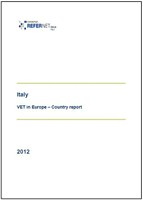Italy VET in Europe. Country report 2012
Il country report fa parte di una serie di rapporti sull'istruzione e la formazione professionale realizzati da ognuno degli stati membri, Norvegia e Islanda membri delle rete Refernet, costruita da Cedefop (Centro europeo per lo sviluppo della formazione professionale). ISFOL è capofila del consorzio italiano di Refernet.
The country report is part of a series of reports on vocational education and training produced for each EU Member State plus Norway and Iceland by members of ReferNet, a network established by Cedefop (European Centre for the Development of Vocational Training).
Naviga il web book
- 1. External factors influencing VET
-
1.1. Population and demographics 1.2. Economy and labour market indicators 1.3. Educational attainment of the population
- 2. Providing VET in a lifelong learning perspective
-
2.1. National Education and Vocational Training System Framework
2.2. Government-regulated VET provision
2.2.1. Three and four-year education and vocational training courses
2.2.2. Post-Secondary higher technical training system
2.2.4. The apprenticeship system
2.2.5. Teachers' and trainers' profiles
2.2.6. VET provision quality assurance
2.3.1. Continuing VET training
2.3.2. Training provided by employers
- 4. Promoting Participation in VET
-
4.2. Tax incentives available for education, training and professional updating






